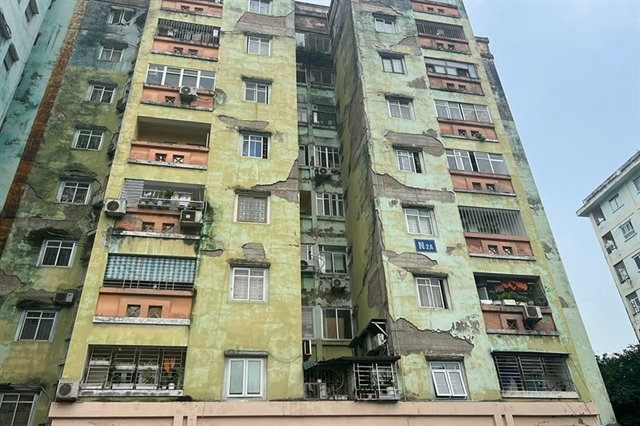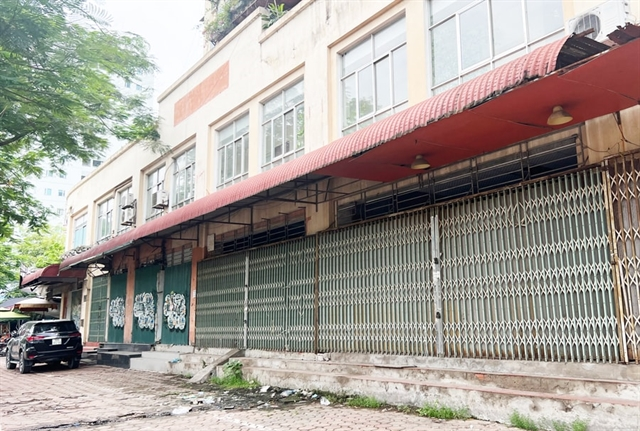
A seriously degraded resettlement apartment building in Trung Hòa Ward, Hà Nội. — Photos hanoimoi.vn
But after 24 years since the first building was put into operation, many of their facilities – including elevators, wastewater drainage and fire fighting systems – have been seriously degraded, affecting residents' lives.
Maintenance and repair have not been carried out properly or in a timely manner due to lack of maintenance funds.
The most degraded buildings are in the Đền Lừ Resettlement Area of Hoàng Mai Ward.
The buildings, which were put into use in 2021, have several cracks around their foundations and bases, but no renovation or repair work has been carried out.
In building A1, many structural elements have shifted from their original construction positions, requiring extensive reinforcement. To ensure safety, the building management unit has had to fence off the area with corrugated iron and prohibit the use of the ground floor.
Moreover, the upper parts of the apartments have been altered and extended into makeshift 'iron cages', placing additional heavy loads on the buildings while the foundations and bases have already cracked and subsided, posing significant safety risks.
Nguyễn Thị Hà, a building resident, told hanoimoi.vn: “The quality of the construction is seriously degraded. The building's elevator system also frequently breaks down for long periods of time, making it difficult for residents to move around. We are very upset.”
The Đồng Tàu Resettlement Area in Thịnh Liệt Ward is another seriously deteriorated site.
After 19 years of use, what most worries residents of the area's ten apartment buildings are the widening cracks in the foundations.
Walls, ceilings and the front and back surfaces of the structures are also peeling and crumbling, with large sections falling off and posing serious hazards. The drainage and septic systems also frequently malfunction, causing wastewater to overflow into flower beds and pavements, leading to serious environmental pollution, according to residents.
Also concerning is that the elevators, water pumps and generators regularly break down, and the lightning protection system is frequently out of order.
Many resettlement areas in Cầu Giấy, Tây Hồ and Thanh Xuân are in the same situation.
And it's not just old resettlement apartment buildings that are degrading – newly built tower blocks are also facing some of the same problems.
One example is a residential area in Bắc Từ Liêm.
Resident Nguyễn Huy Dũng said that water pipes are leaking everywhere, especially in the basement parking area.
Due to untimely repairs, water from the broken pipes is now seeping into the walls and ceilings, dripping onto the floors day and night, Dũng said.
As the building has deteriorated, foul odours frequently emanate from the drainage system, and for a long time now, the communal activity room has been closed. Residents have had to hold meetings temporarily in the lobby, he added.
Abandoned kiosks

Kiosks in the Đền Lừ Resettlement Area were not used due to regulations on auctions.
In addition to the degradation of resettlement apartment buildings, many ground-floor commercial spaces in these residential areas are left abandoned and become increasingly dilapidated and run-down over time, while residents living in the apartments nearby suffer from a lack of markets and essential services.
Around abandoned kiosks, wild grass grows thick, and many areas have become dumping grounds.
Nguyễn Văn Mạnh, head of the management board of building N3B in the Trung Hòa-Nhân Chính Urban Area, said: “Seeing the kiosks on the ground floor left empty for years saddens us greatly, while the area lacks markets and other essential services, so the residents' basic needs are not being met.”
“We have repeatedly asked the city's departments and branches to take measures to speed up the auction of lease rights, put the first floor area of the buildings into use, avoid degradation and waste, and increase budget revenue, but after waiting for a long time, we still see... abandoned buildings,” he added.
Causes and solutions
There are many reasons for the deteriorated and abandoned state of the resettlement apartment buildings in Hà Nội.
First, the establishment of management boards at resettlement apartment buildings has been slow. To date, only 119 out of 201 buildings have established a management board. Meanwhile, the handover of maintenance funds, documents, shared and private usage areas, community rooms and equipment systems – along with the general management and operation of the buildings – from investors to these boards has been slow, with many still not completed.
Second, maintenance and repair work carried out by management and operating units at resettlement apartment buildings remains behind schedule and does not meet the required standards, causing frustration among residents currently living in these buildings.
Đặng Trần Trung, deputy director of the Hà Nội Housing Management and Development Company – the unit currently managing resettlement buildings – said that many of the buildings put into use from 2001 to 2010 have deteriorated across multiple categories and require large repair budgets.
However, maintenance funds are limited. At present, 40 buildings have less than VNĐ100 million (US$3,900) in maintenance funds and 13 buildings put into use before the Housing Law of 2005 do not have a maintenance fund at all, Trung said.
Moreover, current property owners are not contributing financially, making it impossible to renovate, repair or replace deteriorated components in accordance with regulations.
Trung also noted that the main reason for abandoned commercial-service facilities in these buildings is due to changes in policies related to the management and leasing of these spaces.
Starting in 2021, the leasing of commercial-service spaces in resettlement buildings is required to go through auction procedures. However, delays in preparing, appraising and approving rental price schedules due to continuous policy changes have left more than 21,500sq.m of space still idle, awaiting completion of auction procedures.
In addition, starting prices for auctions at certain locations are relatively high, while some spaces have poor investment potential and are not commercially attractive, making people reluctant to participate in auctions. Trung cited buildings in Cầu Giấy and Thanh Xuân resettlement areas as an example.
Some commercial spaces are also not eligible for auction in 2025 because management units have not developed or submitted plans for managing and exploiting public assets, he said.
The inability to lease business premises also deprives apartment buildings of revenue for repairs and maintainance, Trung added.
In recent years, the city authority has carried out projects repairing degraded resettlement apartment blocks, but the number of repairs has been very modest.
Deputy Director of the Hà Nội Construction Department Mạc Đình Minh said: “In order to overcome the shortcomings in maintenance, renovation and repair work at resettlement buildings, the Hà Nội Civil Construction Investment Project Management Board was assigned to carry out the upgrade of fire prevention and fighting systems for resettlement apartment buildings in the area.”
In 2023 and 2024, after the Hà Nội People’s Committee approved revenue-expenditure estimates for leasing business premises owned by the State at resettlement and commercial apartment buildings, resettlement housing management also carried out periodic maintenance at the buildings, including repair work on some elevators and generators.
Since August 2024, if maintenance funds are insufficient, apartment owners are required to contribute additional funds for the maintenance of shared property areas.
The Hà Nội Housing Management Centre was tasked with studying and developing regulations to review, list and implement projects for the renovation, repair and maintenance of shared-use facilities in deteriorating resettlement apartment buildings, said Minh.
New regulations are expected to help resolve current shortcomings, as well as accelerate renovation, repair and maintenance projects for degraded resettlement apartment buildings, thereby ensuring better living conditions for residents, he added.